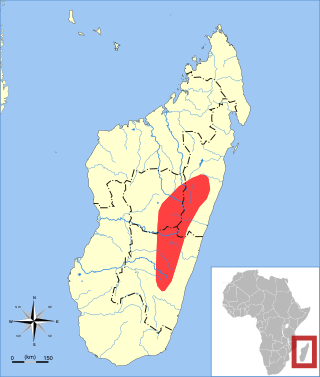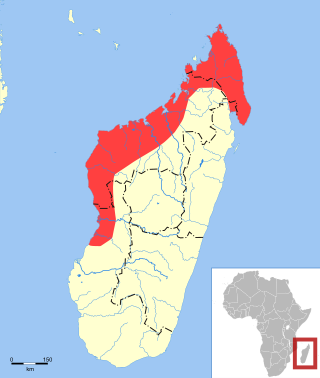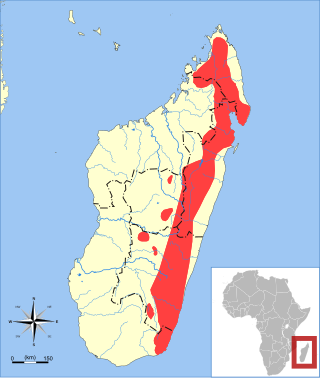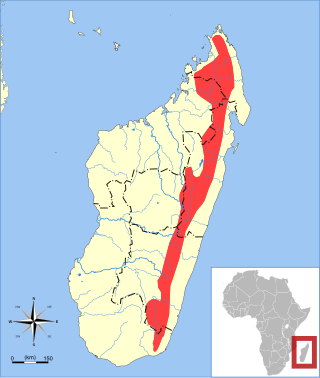
A tenrec is any species of mammal within the afrotherian family Tenrecidae, which is endemic to Madagascar. Tenrecs are a very diverse group; as a result of convergent evolution some resemble hedgehogs, shrews, opossums, rats, and mice. They occupy aquatic, arboreal, terrestrial, and fossorial environments. Some of these species including the greater hedgehog tenrec, can be found in the Madagascar dry deciduous forests. However, the speciation rate in this group has been higher in humid forests.

The web-footed tenrec, Malagasy otter shrew, or aquatic tenrec is the only known semiaquatic tenrec, and is found in eastern Madagascar, especially in and around Ranomafana National Park. It grows to between 25 and 39 cm, and was once thought to be extinct. It feeds on crabs, aquatic insects, and crayfish. The population is considered vulnerable. It was formerly placed in the monotypic genus Limnogale, but has been moved to Microgale based on molecular data showing it to be deeply nested within the latter.

Major's tufted-tailed rat is a species of rodent in the family Nesomyidae. It is found only in Madagascar. Its natural habitat is subtropical or tropical dry forests. It is threatened by habitat loss. The species was named in honor of Swiss zoologist C. I. Forsyth Major.

The short-tailed shrew tenrec is a species of mammal in the family Tenrecidae. It is endemic to Madagascar. Its natural habitats are subtropical and tropical dry and moist lowland forests.
Microgale is a genus of mammal in the family Tenrecidae. There are 21 living species on the island of Madagascar and one extinct species known from a fossil. Some species have been discovered in the last twenty years.

Cowan's shrew tenrec is a species of mammal in the family Tenrecidae.

Dobson's shrew tenrec is a species of mammal in the family Tenrecidae. It is endemic to Madagascar. Its natural habitats are subtropical or tropical moist forests, plantations, and heavily degraded former forest. On the basis of molecular data indicating that it and Talazac's shrew tenrec form a sister group to the rest of Microgale, these two species were transferred from Microgale to Nesogale in 2016.

Drouhard's shrew tenrec, also known as the striped shrew tenrec, is a species of mammal in the family Tenrecidae. It is endemic to Madagascar. Its natural habitats are subtropical and tropical moist lowland and montane forests.

The dryad shrew tenrec, also known as the tree shrew tenrec, is a species of mammal in the family Tenrecidae. It is endemic to Madagascar. Its natural habitat is subtropical or tropical moist lowland forests.

The pale shrew tenrec, also known as the pale-footed shrew tenrec is a species of mammal in the family Tenrecidae. It is endemic to Madagascar. Its natural habitats are subtropical and tropical moist lowland and montane forests.

The gracile shrew tenrec is a species of mammal in the family Tenrecidae. It is endemic to Madagascar. Its natural habitat is subtropical or tropical moist montane forests.
Jenkins's shrew tenrec is a species of mammal in the family Tenrecidae. It is endemic to Madagascar. Its natural habitats are subtropical or tropical dry forests and shrubland. It is threatened by habitat loss.

The lesser long-tailed shrew tenrec is a species of mammal in the family Tenrecidae. It is active at all hours of the day and night, but each individual maintains its own pattern of rest and activity.

The montane shrew tenrec is a species of mammal in the family Tenrecidae. It is endemic to Madagascar. Its natural habitat is subtropical or tropical moist montane forests.

Nasolo's shrew tenrec is a species of mammal in the family Tenrecidae. It is endemic to Madagascar. Its natural habitats are subtropical or tropical moist montane and dry forests.

Talazac's shrew tenrec is a species of mammal in the family Tenrecidae. It is endemic to Madagascar. Its natural habitats are subtropical or tropical moist forests. On the basis of molecular data indicating that it and Dobson's shrew tenrec form a sister group to the rest of Microgale, these two species were transferred from Microgale to Nesogale in 2016.

Thomas's shrew tenrec is a species of mammal in the family Tenrecidae. It is endemic to Madagascar. Its natural habitat is subtropical or tropical moist lowland forests.

The northern shrew tenrec is a species of mammal in the family Tenrecidae. It is endemic to Madagascar, where it has a restricted disjoint range in two locations 485 km apart in the north and east of the island. In the north, it is found on the southwestern slopes of the Tsaratanana Massif at elevations from 1420 to 1680 m. In central eastern Madagascar, it is found in the Ambatovy Forest. Its natural habitat is montane forest. The species is most closely related to the widely distributed M. cowani. This tenrec is threatened by deforestation from agricultural conversion, lumbering and mining.
Oryzorictinae is a subfamily of tenrecs endemic to the island of Madagascar. It is the largest of three tenrec subfamilies. Oryzorictinae is thought to have split from the lineage of its closest relative, Geogale, about 30 million years (Ma) ago. The deepest phylogenetic split within the subfamily, that between Oryzorictes and a clade composed of Microgale plus Nesogale, is thought to have occurred about 28 Ma ago. In turn, Microgale and Nesogale are thought to have diverged about 19 Ma ago.

















